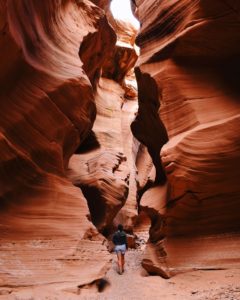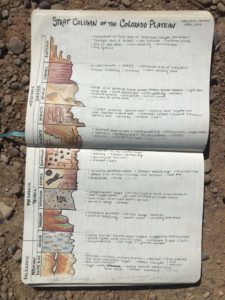The trail has taught me many lessons; but the one I keep relearning is the art of slowing down.
 My foot slips below the surface, only to be enveloped completely by the thick, slow moving quicksand. I take a deep breath and begin to extract myself. The weight of my backpack, along with my body weight rest on one leg, pushing against the soft ground as I move at a snail’s pace to pull my other leg out. The faster I move, the tighter the sand grasps onto my leg, so each move I make is deliberate and delicate. Every step in the Dirty Devil, an 80-mile tributary of the Colorado River, goes like this. The river takes its toll: sandals full of stones, steeped in mud; calves sore from pulling feet from quicksand over and over again. However, I have noticed the river takes its greatest toll when you move too fast. The quicksand only deepens, unless you slow down. The current will knock you over if you don’t take the time to stabilize yourself. The landscape will go unnoticed if you rush through it.
My foot slips below the surface, only to be enveloped completely by the thick, slow moving quicksand. I take a deep breath and begin to extract myself. The weight of my backpack, along with my body weight rest on one leg, pushing against the soft ground as I move at a snail’s pace to pull my other leg out. The faster I move, the tighter the sand grasps onto my leg, so each move I make is deliberate and delicate. Every step in the Dirty Devil, an 80-mile tributary of the Colorado River, goes like this. The river takes its toll: sandals full of stones, steeped in mud; calves sore from pulling feet from quicksand over and over again. However, I have noticed the river takes its greatest toll when you move too fast. The quicksand only deepens, unless you slow down. The current will knock you over if you don’t take the time to stabilize yourself. The landscape will go unnoticed if you rush through it.
The miles are long and our pace is languid. Like a river, I must also meander.
With the ever-growing speed of society, it feels rare and special to move at this pace, to take the time to notice. I have felt these changes in pace particularly in my heightened sense of beauty in this landscape and my urge to encapsulate it in my artwork. The canyon begs to be captured. From its sweeping sandstone walls to the blossoming asters. I find myself in awe of the sea of complimentary colors: the deep purple shadows, next to tangerine Navajo Sandstone cliffs, below cloudless lapis blue skies. The landscape radiates with a vibrancy unlike any other I’ve seen and the leisurely pace of life in the backcountry has given me ample time to develop my connection and sense of place within this landscape; forming an intimate relationship with the land in this way has filled me with a deep urgency to protect the beauty I have been immersed in over the last month.
On the second-to-last day of our journey in the Dirty Devil, we took a day hike to Happy Canyon, a side canyon of the Dirty Devil. Here, at the end of our journey, I had the opportunity to practice the slow pace of life that the river has taught me. It was as though we were entering a museum. The group grew silent as we were enveloped by the steep walls of the slot canyon. The delicate White Rim Sandstone walls folded and bended tenderly; the sliver of blue sky one can see from the sandy canyon floor illuminates the tall vertical walls, creating a striation of subtle lavenders, buttery yellows, indigo shadows, and persimmon orange. We walked, layers below the earth’s surface in silent awe, following the gentle curves of the canyon. The textures ebb and flow as we move through the walls: from the side, gentle stripes moving with the flow of an ancient river. From below, layers stacked upon each other like a topographic map. In our silence, we wander: breathing in the cool air and feeling channeled wind on our faces. The sounds of the canyon reverberate through its hallowed walls: the wind whispering from far above, the whistles of a classmate singing through the ripple marks. Deep within the earth, one feels a reverent presence and heightened intimacy with the land. 
I am almost brought to tears as I remember a recent reading we had for class. The very layer I find so stunning, White Rim Sandstone, also holds one of the most valuable substances known to modern man: tar sands. This unconventional source of oil demands intense extraction methods, primarily strip mining, which would remove the many layers of the Dirty Devil that I have spent the last two weeks getting to know and understand. The canyon I stand in, the canyon I am so moved by; the most beautiful place I have ever been, now, teeming with juniper trees, asters, and many small creatures could be destroyed in order to fuel the world’s ferocious demand for oil.
Utah’s public lands, such as Happy Canyon, have a deep and complex history of extraction. The rapid boom and bust of the oil industry intertwines the state of Utah, the American government, and, most significantly, the people living in the rural towns of Utah. The development of the oil industry in this region will provide short-term jobs and long-term destruction of both the land and the people of the Colorado Plateau. As our lessons on WRFI have taught us about the resilience of both the people and land on the Colorado Plateau, I wonder what would happen if the fast-paced oil economy could understand the slow pace of the very canyon it is exploiting.
It is crucial, not only for the land, but also for the people of the Colorado Plateau, to establish resiliency in environmental, economic, and political actions. As a land with massive untapped potential for exploitation, Utah stands in a vulnerable position. With people making political and economic decisions about its lands that I worry do not come from a respect or understanding of these wild places.
Perhaps, if developers took a walk down the Dirty Devil River and Happy Canyon; if they knew each layer of the earth they saw; if they could name each flower under their foot and bird that flew overhead; if they saw the canyon for the teacher that it is and took the time to learn from it, in its slow, resilient beauty. If they took the time to notice; maybe then they couldn’t bring themselves to break its skin.
One Reply to “Lena Connolly: Lessons in Patience From the Dirty Devil River”
Comments are closed.
Your beautiful writing brings alive Dirty Devil and animates my own heart’s call to change my pace, to listen, to love. thank you.